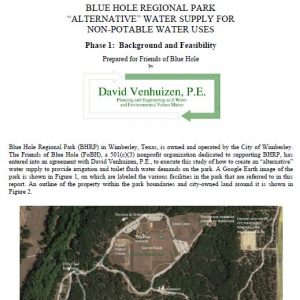Blue Hole Regional Park “Alternative” Water Supply for Non-Potable Water Uses

The Friends of Blue Hole commissioned an engineering study by David Venhuizen, P.E. of alternative water supplies to provide irrigation and toilet flush water demands on the park. The study was presented to the Wimberley Parks Board on Feb. 22, 2022. The report is archived here.
Phase 1: Background and Feasibility
It is desired to create a water supply for irrigation and other non-potable water uses on Blue Hole Regional Park that would not tax the potable water supply system, and that would be as sustainable as practical and feasible. This study is being conducted to investigate options that would fulfill this desire. In this Phase 1 report, the water demands that have been identified to be provided by any “alternative” supply scheme are set forth, the irrigation water demands and flush water demands to be served are estimated, the options identified to create the water supply are generally reviewed, and the institutional/regulatory obstacles confronting those options are analyzed. Friends of Blue Hole will consider the options and determine which are to be pursued further in Phase 2.
Phase 2: Review of Options
Upon reviewing the Phase 1 report, the Friends of Blue Hole directed that Phase 2 consider two options to provide irrigation water on Blue Hole Park:
-
- Implement a treatment plant that would be installed by the City of Wimberley under the permit it currently has in hand, which was intended for a treatment plant to serve the broader community.
- Implement a treatment plant that would be, nominally at least, owned by Aqua America/Aqua Texas (Aqua) under the program outlined in section 321P of the Texas Administrative Code.
Under either approach, a number of matters would need to be resolved in order to understand how a treatment plant would be practically implemented and operated. These matters are first reviewed, including a rundown on the status of the information needed to evaluate them. Then a “best guess” of how to proceed is laid out, and cost estimates for that course of action are offered. A review of the two regulatory pathways completes this report.